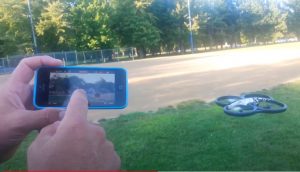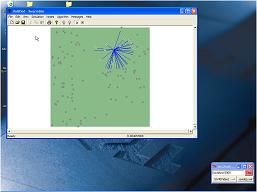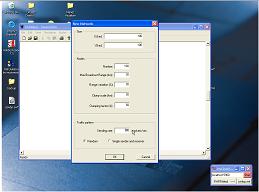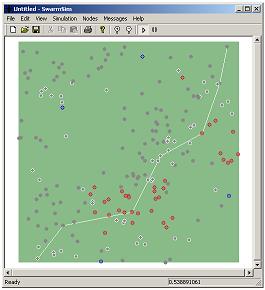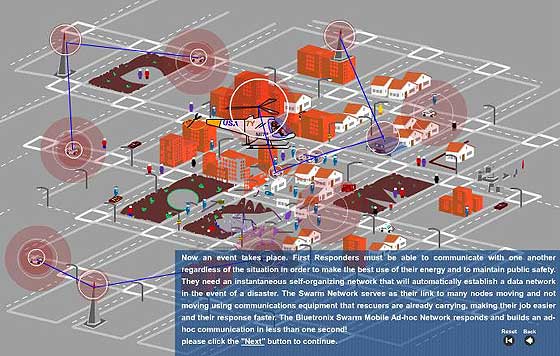Bluetronix Swarm Demonstrations (Simulation and Emulation)
Swarm Edge® Drone Demos
An off-the-shelf drone, modified by embedding a Swarm Edge® chip, is controlled by a non-internet based wireless app installed mobile phone. To view the demonstration, click here.
5 Principles of Swarm Intelligence
Swarm Technology’s strategically important issued patents define the architecture for Plug-and-Play Intent-Based Autonomy, Proactive Autonomy, and Heterogeneous Interoperability in networking and robotics.
Swarm intelligence’s cognitive algorithm should be compliant with the same behavioral principles exhibited by social insects:
Simulation of Swarm Routing (without Learning)
Click the graphic below to view a demonstration of Bluetronix’s SwarmSim software running a routing algorithm without the “learning” benefits of the Swarm Autonomous Routing Algorithm.
Simulation of Swarm Routing (with Learning)
Click the graphic below to view a demonstration of Bluetronix’s SwarmSim software running the Swarm Autonomous Routing Algorithm.
This simulation shows 100 nodes scattered over a 100 × 100 square km area. There is no prior knowledge by any the nodes of location or for that matter any information. Broadcast range is 30 km and a single sender and receiver is chosen. This option is chosen because it is easier to see the paths chosen for routing to a single destination. A white line illustrates a completed path between sender and receiver, and hence a delivered message. The blue lines represent broadcasts. Statistics are shown. The first demonstration is without learning with the swarm and performs real well. The second demonstration is with learning by calculating “bi-directional pheromones,” and the results are even better! To view the demonstration, click the picture below. Thank you for your interest in Bluetronix and swarm routing for mobile ad hoc networks.
SwarmSim Demo Download
The SwarmSim Demo is a program designed to demonstrate the performance of Bluetronix’s swarm autonomous routing algorithm. For information on SwarmSim, including a downloadable demo version, click here.
First Responders Flash Demo
First Responders must be able to communicate with one another regardless of the situation in order to make the best use of their energy and to maintain public safety. They need an instantaneous self-organizing network that will automatically establish a data network in the event of a disaster. The Swarm Network serves as their link to many nodes moving and not moving using communications equipment that rescuers are already carrying, making their job easier and their response faster. The Bluetronix Swarm Mobile Ad-hoc Network responds and builds an ad-hoc communication in less than one second!
As we show in this demonstration, each node in an ad-hoc network is the destination of some information packets while at the same time it can function as relay station for other packets to their final destination. This multi-hop support is the way Swarm ad-hoc networks function, making communication between nodes outside direct radio range of each other now possible in the event of a disaster or loss of communication with the network infrastructure. Therefore the system will work even if 90% of it is destroyed.
Swarm-T Tracking & Tagging Demonstration
Swarm Edge® can be used to track items or personnel using GPS. Click here to view the demo.
| SYSTEM COMPONENTS | KEY CAPABILITIES |
|---|---|
| Smart Device with Swarm-T Code (phones, tablets, laptops, etc.) | Collective Self-Learning in a Swarm-like Mode |
| Radio Transceiver (tagging device & Ad-Hoc Networking Conduit) embedded with Patented Swarm-T Ad-Hoc Networking and Location Service Code. | Ad-Hoc networking, Self-Learning, Self-Healing,; Information Gathering & Controlling if needed when properly equipped. |
Swarm Edge® Building Monitoring Demo
This demonstration exhibits how SWARM-T can be implemented to monitor the state of multiple sensors across a wireless network, triggering an alert to a wireless device (in this case a mobile phone), if certain programmable criteria are met (i.e. if the temperature falls below a certain threshold, if smoke is detected, or a required security connection is broken). To view the demonstration, click here.
Swarm-T Monitoring & Control System
Can Be Formed on Ad-Hoc Basis with No Prior Set-Up
System Components
- Gateway Unit (Communication via Cell or Other) & Microcontroller (with SWARM-T embedded software)
- Wireless key Pad (for optional adjustments)
- Wireless Sensors for Monitoring (e.g. Temperature, Liquid presnece, Smoke, Pressure, Motion, etc.)
- Wireless Sensors for Control (e.g. On/Off Fab, Actuators, Motion Control, etc.)
NOTE: System components equipped with embedded SWARM-T software can be added/removed on AD-HOC network Basis without prior preparation.
CLOSE PROXIMITY OF COMPONENTS NOT REQUIRED!
Swarm Edge® Security Monitoring Demo
This video demonstrates how SWARM-T can monitor the security status of multiple nodes across a wireless network, triggering an alert to a wireless device (in this case a mobile phone), if certain pre-defined requirements are not met. To view the demonstration, click here.
Emulation Demos
(Note: It is important to go through the Readme file before downloading and running the demos by following the link “Readme File” below.)
[Readme File] [Console Based Visualizer Guide] [3-D Visulazier Guide] [Visualizer User Guide]

